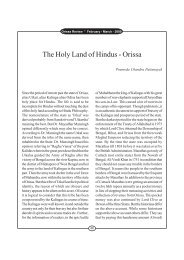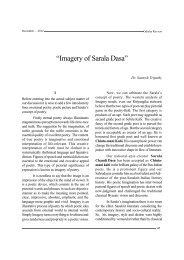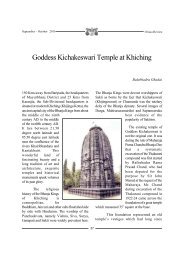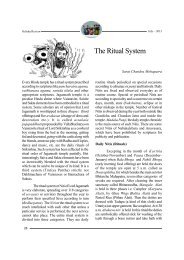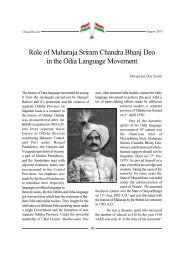The Cult of Saktism in Orissa - Government of Orissa
The Cult of Saktism in Orissa - Government of Orissa
The Cult of Saktism in Orissa - Government of Orissa
Create successful ePaper yourself
Turn your PDF publications into a flip-book with our unique Google optimized e-Paper software.
stand<strong>in</strong>g posture with four arms, hold<strong>in</strong>g garland<br />
<strong>of</strong> beads, noose, pitcher <strong>of</strong> nectar and <strong>in</strong> Japamudra.<br />
She is worshipped <strong>in</strong> Bhubaneswari<br />
mantra except on 7th, 8th and 9th bright days <strong>of</strong><br />
the month <strong>of</strong> Asw<strong>in</strong>a when non-vegetarian food<br />
is <strong>of</strong>fered to Her.<br />
Vimala is described as Supreme<br />
Vaishnavi goddess who takes Kaibalya or<br />
Mahaprasad <strong>of</strong> Lord Jagannath as her only food<br />
unlike other goddesses <strong>in</strong> Jagannath temple. She<br />
goes to bed only after Lord Jgannath retires.<br />
Vimala is most closely associated with the rituals<br />
<strong>of</strong> Lord Jagannath compared to other goddesses<br />
<strong>in</strong> the temple. When goddess Lakshmi has her<br />
separate arrangement for cook<strong>in</strong>g other than<br />
Mahaprasad, Vimala takes Mahaprasad<br />
throughout the year except on 7th, 8th and 9th<br />
bright days <strong>of</strong> the month <strong>of</strong> Asw<strong>in</strong>a. Dur<strong>in</strong>g these<br />
days <strong>of</strong> Durga Puja, she is <strong>of</strong>fered two goats a<br />
day on each <strong>of</strong> the three days (total six goats) as<br />
sacrifice to Her due to the <strong>in</strong>fluence <strong>of</strong> 'Bamachar<br />
worship' <strong>of</strong> <strong>Saktism</strong> which seems to be a later<br />
<strong>in</strong>troduction. <strong>The</strong> sacrifice <strong>of</strong> goats to Mother<br />
goddess is done late <strong>in</strong> the night after Lord<br />
Jagannath goes to bed which clearly shows that<br />
the priests <strong>of</strong> Lord Jagannath do not co-operate<br />
with Bamachar worship <strong>of</strong> Vimala and such<br />
worship is be<strong>in</strong>g performed by a few Bamachar<br />
worshippers <strong>in</strong> Vimala temple. <strong>The</strong> rituals <strong>of</strong> Lord<br />
Jagannath are based on Sudhachar only. <strong>The</strong><br />
domed ro<strong>of</strong> <strong>of</strong> Vimala with its <strong>in</strong>ner surface reveal<br />
the figures <strong>of</strong> Vaishnavism. Though Vimala, the<br />
first and foremost deity <strong>of</strong> Uddiyan (<strong>Orissa</strong>) has<br />
been described as Bhairabi and Lord Jagannath<br />
as Bhairaba, the Vaishnavites treat her as wife <strong>of</strong><br />
Lord Balabhadra.<br />
Out <strong>of</strong> sixteen days <strong>of</strong> Durga Puja <strong>in</strong> the<br />
month <strong>of</strong> Asw<strong>in</strong>, Goddess Vimala does not wear<br />
any specific attire on first and last four days.<br />
Dur<strong>in</strong>g the rest eleven days, she is adorned as<br />
<strong>Orissa</strong> Review September - 2009<br />
32<br />
Bhubaneswari, Bana Durga, Rajarajeswari,<br />
Ugratara, Matang<strong>in</strong>i, Bagala, Narayani,<br />
Simhabah<strong>in</strong>i, Jaya Durga, Shuli Durga and<br />
Harachandi respectively.<br />
From the 8th dark day to the new moonday<br />
<strong>of</strong> Asw<strong>in</strong> (eight days), Durga -Madhab<br />
(Durga and Madhab or Jagannath fastened<br />
together on a wooden platform) are seated on a<br />
cot <strong>in</strong> the Jagamohan <strong>of</strong> Vimala temple and from<br />
first bright day to n<strong>in</strong>th bright day take up on a<br />
journey to Narayani temple <strong>of</strong> Dolamandap Sahi<br />
on a chariot which is known as Sakta gundicha<br />
or Car Festival <strong>of</strong> Durga Madhab.<br />
Viraja :<br />
Viraja - tirtha on the sacred bank <strong>of</strong> river<br />
Baitarani found its celeberation dur<strong>in</strong>g<br />
Mahabharat days and commemorates ten Horse<br />
Sacrifices (Dasaswamedha Yajna), conducted by<br />
Lord Brahma <strong>in</strong> Puranic age and Yayati Keshari-<br />
I, the k<strong>in</strong>g <strong>of</strong> 10th century A.D. It has got its early<br />
name and fame as a Sakti-pitha <strong>in</strong> the Puranas<br />
like Visnu Purana, Brahma Purana, Kapila<br />
Samhita, Kubjika tantra, Jnanaranaba tantra<br />
and Brihannila tantra etc. It is said that the<br />
goddess emerged from the sacrificial fires <strong>of</strong> the<br />
Aswamedha Yajna.<br />
Viraja mostly rema<strong>in</strong>s clothed. She firmly<br />
holds the tail <strong>of</strong> buffalo-demon by her left hand<br />
and pierces it with a spear by the right. Image <strong>of</strong><br />
goddess with two hands dates back to 4th or 5th<br />
century A.D. It is one <strong>of</strong> the fifty-one dist<strong>in</strong>guished<br />
Sakti-shr<strong>in</strong>es <strong>of</strong> India, erected from the sacred<br />
navel - chord <strong>of</strong> goddess Sati. <strong>The</strong> n<strong>in</strong>e day -<br />
festival <strong>of</strong> Durga Puja is celebrated with great<br />
fanfare and on the fifth day <strong>of</strong> the function, the<br />
car festival <strong>of</strong> Viraja is celebrated by thousands<br />
<strong>of</strong> devotees from all around which is known as<br />
'Sakta-Gundicha'. Some are <strong>of</strong> op<strong>in</strong>ion that<br />
Viraja is no other than Prajna - Paramita <strong>of</strong><br />
Buddhism.




